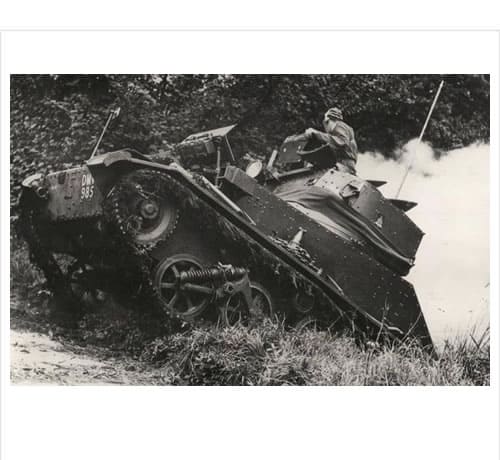Image: 1938- Squadron leaders Vickers Light Tank of the 4th Queen’s Own Hussars climbs out of a ditch during manoeuvres of the 1st and 2nd British Division, Hampshire, England.
The Tank, Light, Mk VI was the sixth in the line of light tanks built by Vickers-Armstrongs for the British Army during the interwar period.
The company had achieved a degree of standardisation with their previous five models, and the Mark VI was identical in all but a few respects. The turret, which had been expanded in the Mk V to allow a three-man crew to operate the tank, was further expanded to give room in its rear for a wireless set.
The weight of the tank was increased to 10,800 pounds (4,900 kg), which although heavier than previous models actually improved its handling characteristics, and an 88 horsepower (66 kW) engine was added to the model to increase its maximum speed to 35 miles per hour (56 km/h). It had the Horstmann coil-spring suspension system, which was found to be durable and reliable, although the fact that the tank was short in relation to its width and that it pitched violently on the rough ground made accurate gunnery whilst moving exceptionally difficult.
The Mk VI possessed a crew of three consisting of a driver, gunner and commander, who also doubled as the radio operator, between 4 millimetres (0.16 in) and 14 millimetres (0.55 in) of armour, which could resist rifle and machine-gun bullets, and its armament consisted of one water-cooled .303 inch and one .50 inch Vickers machine gun.
When the Mk VI was first produced in 1936, the Imperial General Staff considered the tank to be superior to any light tank produced by other nations, and well suited to the dual roles of reconnaissance and colonial warfare. Like many of its predecessors, the Mark VI was used by the British Army to perform imperial policing duties in British India and other colonies in the British Empire, a role for which it and the other Vickers-Armstrongs light tanks were found to be well suited.
When the British government began its rearmament process in 1937, the Mk VI was the only tank with which the War Office was ready to proceed with manufacturing; the development of a medium tank for the Army had hit severe problems after the cancellation of the proposed “Sixteen Tonner” medium tank in 1932 due to the costs involved, and cheaper models only existed as prototypes with a number of mechanical problems.
As a result of this, when the Second World War began in September 1939, the vast majority of the tanks available to the British Army were Mk VIs; there were 1,002 Mk VI Light Tanks, 79 Mk I and Mk II Cruiser Tanks and 67 Mk I Infantry Tanks. Of these tanks, only 196 light tanks and 50 Infantry Tanks were in use by operational units of the army.
The 3rd, 4th 7th and 8th Hussars would all operate the MK VI during the early stages of the war.
When the Battle of France began in May 1940, the majority of the tanks possessed by the British Expeditionary Force (of which the 4th Hussars were part) were Mark VI variants; the seven Royal Armoured Corps divisional cavalry regiments, the principal armoured formations of the BEF, were each equipped with 28 Mk VIs.
The 1st Armoured Division, elements of which landed in France in April, was equipped with 257 tanks, of which a large number were Mk VIB and Mk VICs. The British Army lost 331 Mark VI light tanks in the Battle of France in 1940.
The Mk VIB was also used in the North African campaign against the Italians late in 1940 with the 7th Armoured Division. At this time, the British had 200 light tanks (presumably the Mk VIB) along with 75 cruiser tanks (A9, A10, A13) and 45 Matilda IIs.
An attack by the 3rd Hussars at Buq Buq on 12 December 1940 resulted in its tanks getting bogged down in salt pans and severely mauled. In ten minutes, 13 tanks were destroyed, ten officers and men killed – including the CO – and 13 wounded.
The 7th Armoured Division had 100 tanks left on 3 January 1941; this increased to 120 tanks on 21 January, at which time they were used in flanking far into the rear and gathering up scattered Italian troops, sometimes joining or leaving the main attacks to the Cruiser and Matilda II tanks.
During an engagement at Mechili on 24 January, six Mk VIs were destroyed by newly arrived superior Italian Fiat M13/40s for no loss, forcing a retreat until Cruiser tanks arrived.
Being widely used by the British Army, the tank participated in several other important battles.
The Mk VIB made up a significant amount of the tanks sent over to the Battle of Greece in 1941, mostly with the 4th Hussars.
Ten Mk VIB tanks fought with the 3rd The King’s Own Hussars during the Battle of Crete. The 3rd Hussars had previously embarked a Troop of three MK VIB tanks for the Norwegian Campaign under command of the Irish Guards, but they were lost in transit to a German aircraft attack.
The tanks also saw limited service against the Japanese in Java with ‘B’ Squadron of the 3rd Hussars in 1942 of which all were lost or captured.
The 3rd Hussars was the only Regiment to operate the MK VI in 4 operational theatres and 3 continents.


